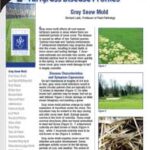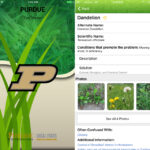Richard Latin
Turfgrass Disease Profiles: Smut diseases (BP-119-W)
Purdue Extension Publication
Smut diseases, caused by several closely related and highly specialized pathogenic fungi, tend to occur on higher cut turf, so they are often found on residential turf, athletic fields, and golf course roughs. This publication describes the symptoms of smut diseases and provides management strategies.
Turfgrass Disease Profiles: Rhizoctonia Large Patch (BP-117-W)
Purdue Extension Publication
Rhizoctonia large patch of zoysiagrass (also called zoysia patch) is the most significant infectious disease of the zoysiagrass species. This publication shows how to identify and manage this turfgrass disease.
Turfgrass Disease Profiles: Necrotic Ring Spot (BP-116-W)
Purdue Extension Publication
Necrotic ring spot infects the roots of Kentucky bluegrass on golf courses, sports turf, professional landscapes, and home lawns. It is seldom a devastating disease, but outbreaks can disturb the appearance of the turf stand and affect playing surfaces. This publication examines the causes of this disease and presents management strategies.
Turfgrass Disease Profiles: Summer Patch (BP-115-W)
Purdue Extension Publication
Summer patch affects Kentucky bluegrass and annual bluegrass on all kinds of turf venues, including golf courses, athletic fields, professional landscapes, and residential lawns. This publication describes summer patch symptoms and discusses a variety of management options.
Turfgrass Disease Profiles: Slime Molds (BP-112-W)
Purdue Extension Publication
Despite their threatening appearance, slime molds are not infectious and will not result in anything more than temporary cosmetic damage. This publication describes the symptoms and signs of slime molds and control methods.
Turfgrass Disease Profiles: Powdery Mildew (BP-111-W)
Purdue Extension Publication
Powdery mildew is a foliar disease of Kentucky bluegrass and some fescues. The disease is rarely responsible for any lasting damage to turf, so its effects are primarily aesthetic. This publication describes the symptoms of powdery mildew and offers control options.
Turfgrass Disease Profiles: Rust Diseases (BP-110-W)
Purdue Extension Publication
Leaf rust outbreaks are most common on residential lawns and low budget athletic fields. It is largely a cosmetic disease, but its orange spores can be a greater nuisance. This publication describes the symptoms and development of this disease, and provides management options.
Turfgrass Disease Profiles: Pythium Blight (BP-109-W)
Purdue Extension Publication
Pythium blight can cause considerable turf damage because it spreads quickly and affects the leaves and crowns. Pythium blight occurs during hot, humid days in the summer. This publication provides control and prevention methods.
Turfgrass Disease Profiles: Anthracnose (BP-108-W)
Purdue Extension Publication
Anthracnose is caused by a fungus that survives and thrives on dead and decaying organic matter, and is primarily a disease of intensively managed annual bluegrass and creeping bentgrass used on golf courses. This publication discusses how to identify anthracnose, and examines options for controlling the disease.
Turfgrass Disease Profiles: Gray Leaf Spot (BP-107-W)
Purdue Extension Publication
Gray leaf spot is a foliar disease that affects perennial ryegrass and tall fescue. Moderate outbreaks of gray leaf spot result in clusters of thin, off-colored turf. Severe outbreaks, however, will result in the death and decay of extensive areas and ruin the entire turf stand. This publication describes the symptoms and development of this disease, and provides management options.
Turfgrass Disease Profiles: Brown Patch (BP-106-W)
Purdue Extension Publication
Brown patch is caused by a fungal pathogen that affects all cool-season turfgrass species. Moderate to severe outbreaks on high-maintenance creeping bentgrass and annual bluegrass can result in thin, poor quality turf that may be predisposed to algae and moss infestation. This publication describes the symptoms and development of this disease, and provides management options.
Turfgrass Disease Profiles: Dollar Spot (BP-105-W)
Purdue Extension Publication
Dollar spot is caused by a fungal pathogen and is a common concern on golf course turf, especially creeping bentgrass and annual bluegrass greens, tees, and fairways, where it can result in poor turf quality and appearance. This publication describes the symptoms and development of this disease, and provides management options.
Turfgrass Disease Profiles: Red Thread (BP-104-W)
Purdue Extension Publication
Turfgrass Disease Profiles: Leaf Spot/Melting Out (BP-103-W)
Purdue Extension Publication
Leaf spot and melting out are different diseases with similar symptoms and pathogen characteristics. They both attack Kentucky bluegrass, perennial ryegrass, and tall fescue, and appear to cause the most damage to golf course roughs, sports turf, and residential lawns. This publication describes the symptoms and development of this disease, and provides management options.
Turfgrass Disease Profiles: Gray Snow Mold (BP-101-W)
Purdue Extension Publication
Gray snow mold affects all cool season turfgrass species in areas where there are extended periods of snow cover. This publication discusses how to identify gray snow mold, and examines options for controlling the disease.
Purdue Launches Turf Diagnostic Mobile App
The Purdue Turf Doctor app, a collaborative effort among Drs. Doug Richmond, Aaron Patton and Rick Latin, is the latest modern turfgrass management tool produced by the Purdue Turfgrass Science team. The app is designed to help homeowners and land managers diagnose and address turfgrass problems caused by a variety of factors including weeds, insects, […]

